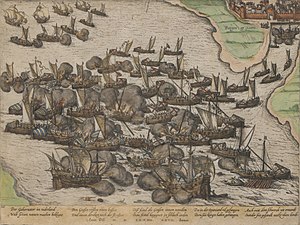Battle of Reimerswaal
| Battle of the Scheldt (1574) | |||||||
|---|---|---|---|---|---|---|---|
| Part of the Eighty Years' War & the Anglo–Spanish War | |||||||
 Battle in the East Scheldt between the Spanish and the beggar fleet as portrayed by Frans Hogenberg |
|||||||
|
|||||||
| Belligerents | |||||||
|
|
|
||||||
| Commanders and leaders | |||||||
|
|
|
||||||
| Strength | |||||||
| 64 ships | 75 ships | ||||||
| Casualties and losses | |||||||
| 300 killed or wounded 2 ships sunk |
15 ships sunk 1200 dead |
||||||
The Battle of the Scheldt also known as the Battle off Walcharen (known in Dutch as Slag bij Reimerswaal) was a naval battle that took place on 29 January 1574 during the Eighty Years' War and the Anglo–Spanish War. The battle was fought between a Dutch rebel Sea Beggar fleet (which included English and Scottish troops) under Lodewijk van Boisot and a Spanish fleet under Julián Romero. The Spanish fleet was attempting to relieve the Spanish held town of Middelburg which was under siege but the fleet under Boisot intercepted them and were victorious with the destruction or capture of nearly fifteen ships. Middelburg as a result then surrendered only nine days later along with Arnemuiden.
In April 1572 the cities of Flushing, Veere and Arnemuiden, located on the island of Walcheren, had sworn allegiance to the Dutch prince. However, another city on the island, Middelburg, remained loyal to the king Philip II of Spain, and as a result was besieged. After more than six months' worth of food, ammunition and other materials began to run out the Spanish commander Sancho d'Avila made a second attempt to resupply the city by sea (his first attempt failed. See Battle of Borsele). A third was turned back after Fort Rammekens was captured in August 1573 by an Dutch and English force.
The Dutch under the Flemming Louis Boisot, Admiral of Zealand wanted to take on the Spanish fleet, and met up with another fleet under Vice Admiral Joos de Moor. At the same time a request was made to reinforce the besiegers around Middelburg. Having picked up sufficient troops which included a number of companies of English and Scots led by Colonel Thomas Morgan, they set out to find the Spanish fleet.
...
Wikipedia
